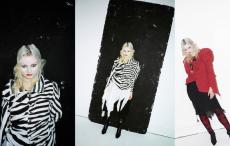セントラル・セント・マーティン卒業コレクション特集: Sarah Garfield /Central Saint Martins Graduate Collections Issue : Sarah Garfield
NeoL / 2021年6月4日 17時0分
セントラル・セント・マーティン卒業コレクション特集: Sarah Garfield /Central Saint Martins Graduate Collections Issue : Sarah Garfield


次なる目となるデザイナーを見出すべく、ファッションシーンの誰もが注目するセントラル・セント・マーティンの卒業コレクション。コロナ禍での修了、卒業制作を迎える学生たちは何を考え、どう己のクリエイションと向き合ったのか。第2回目はゴスを独自に進化させたSarah Garfieldによるコレクションとインタビューを紹介する。(→ in English)
――セント・マーティンのファッション科で学ぼうと思った理由は?
Sarah「BA(学士号)を取得してもまだクリエイティヴにおいて探求することがたくさんあると感じたので、MA(修士号)をとることにしました。BAの勉強を始めたときは裁縫やパターンカットなどがあまりできなかったので、ここでは技術を学ぶことに集中したんです。MAでは学んだこと全てを応用して、デザイナーとしてのアイデンティティをクリエイティヴで完全に表現することができるようになりました。セント・マーティンを選んだのは世界的な知名度を持ち、業界とも長年に渡り密接な関係を築いているから。昔からセント・マーティンでMAを取得することが自分の大きな目標だったんです」
――ロックダウン中の卒業制作、ファイナルコレクションということで、制限や限界を感じたことは?
Sarah「数え切れないくらいあります! でもロックダウンでクリエイティヴを発揮する機会を失ったとは思いません。私はまだ母と3人の弟 (うち2人は高校生) と一緒に住んでいるので、最大限に能力を発揮するための物理的なスペースや静けさは自宅では望めませんでした。また、通常だったらCSMのスタジオで使えた裁縫のマシンや技術的な手助けもなく、仕立て屋もいない。かと言って、その費用を払うこともできません。本来はBAとMAのファッションコースの1年生にアシスタントをお願いできるのですが、ソーシャル・ディスタンスが必要なためこのコラボも実現できませんでした。これはロックダウンとは別に改善が必要な点ですね。コレクションのためのオンライン・フィッティングも実際的でなく、あまりうまくいかかったので、十分なフィードバックを得るには結局のことろ指導してくれていた先生が3Dで服を見る必要が出てきました。まあちょっとうまくいかなかっただけです!
卒業制作が終盤に差し掛かった1月、大学の助けは見込めない中、家では無理だと判断し、自分の資金でスタジオを借りることを決断しました。スタジオは凍えるほど寒くて、ちゃんとしたカッティングテーブルもマネキンも工業用ミシンもない状態でしたが、限られたリソースで楽しみながら最善を尽くしました。ビデオプレゼンテーションのためのデジタル面などの準備も必要になりました。昨年まではモデルやヘアメイク、ショーの場所などといったことをチームでオーガナイズができたけど、今年は自分たちだけで全てを作り上げる必要があったんです。私は幸いにも手伝ってくれる素晴らしいチームに出会えました!
根本的な部分で、生地や糸などのお店を直接訪れられないのも辛かったですね。オンラインで実物を見ることができないまま注文して、アドバイスもオプションもないのですから」

――パンデミックの最中に修士課程を修了しましたが、ファッション業界へ進むための準備はどのように進めましたか。制作過程は全体的に何か変化がありましたか。
Sarah「限られたリソースとほとんどお金を使わない状態で、真の意味での自分のデザインができました。CSMの美しく広々とした設備の整ったスタジオでコレクションを作ることは限られた人にだけ許された特権ですが、デザインのスキル自体は、高いマシンや高価な材料ではなく、自分にこそ宿っているも。それがわかった今は、今後の人生で何が起ころうとも、ほんの少しのもので素晴らしい作品を生み出すことができるでしょう。
これは、自分のブランドをどのようにしたら立ち上げることができるかという日頃から考えていた問題へのアプローチとしても素晴らしい気づきになりました。多くを持ってから立ち上げるのではなく、限られた条件の中でもやれるということがわかったのですから。
クリエイティヴ・プロセスの変化としては、私ははるかに柔軟に、より直感的に制作するようになりました。例えば素材へのアクセスが限られていたため、家族や友人から譲り受けたり、すでに持っていた生地を使って服を作り直しました。パターンカッティングへのアプローチでは、従来のフラットパターンカッティングではなく、マネキンに直接ドレープすることで、自分が望む形状とシルエットを作ることができるとわかりました。それによってCSMスタジオでパターンカッターの助けを借りる必要がなくなったので大いに助かりましたし、自分で問題を解決することで、より興味深い結果を出すことができたんです。
春のロックダウン中は、編み物を覚えることに多くの時間を費やしました。常に学びたいと思っていたものの、以前はウィメンズウェアの色々なやり方について学ぶ時間が足りなくてできていなかったんです。一旦編み物をマスターしたら、手編みと機械編みの両方に夢中になって、最終的にはそれらがコレクションのとても重要なパートを占めるようになりました」
――セント・マーティンであなたのデザイン哲学を変えたクラス、将来の仕事の役立つクラスはありましたか。
Sarah「Reba Mayburyによる『Fashion Context and Theory』と、Tod'sと実際に行ったブリーフィングです。Rebaのクラスでは、ファッション業界における性別や人種、セクシュアリティ、階級などのトピックを取り巻くステレオタイプの表現について調べました。このクラスではデザイナーにハイライトを当てているため、ファッション業界で自分たちが文化的および政治的にどのポジションにいるのか、自分自身をどのように表現し、どんな人物を表現しているかをしっかり認識する必要があります。今の時代には特に必要不可欠ですが、自分の作品が進歩的で包括的な方向を歩んでいるかを常に疑問視することも重要です。
そのようなことを身につけ、最後には、作品、そしてデザイナーの意図を表したマニフェストと理論的根拠を書くことになります。このクラスは、作品を通じて私が伝えたいことや表現したいことを理解し、自分のコミュニティやマーケットを見極めるのにとても役立ってくれました。
Tod'sとのプロジェクトでは、ブランドとマーケットレベルを対象としたシューズのカプセルコレクションを5つデザインするように依頼されました。より商業的に考えルコとや、自分のデザイン・アイデンティティとクリエイティヴ・プロセスをクライアントに合わせて適応させる方法を学び、素材の仕様や製造の準備が整った状態で、いかにより技術的なデザインをするかという方法を学びました。私の卒業制作は非常にクリエイティヴで表現力に富んでいるので、このプロダクトにフォーカスしたプロジェクトが私のポートフォリオを違う側面から強化してくれると思います」

――卒業コレクションについて教えてください。
Sarah「堕落し、恐ろしいような不完全な美のあらわれ。怒り、痛み、悲しみを真っ直ぐに表現したものです。私のコレクションは、純粋に自分と自分のスタイルのアイデンティティを誠実に表現したものです。自分をさらけ出すことは時に苦痛ですが、そこには美しさと生々しさがあると思います。10代をゴスとして過ごしたヤングアダルトとして、サブカルチャーの歴史の中でコードを繋ぎ直したり解いたりして、既存の慣例をこわし、私自身の新しいコードを構築しようとしました。
全体的な“見た目”や文化的な文脈だけでなく、裁断、制作、テキスタイル開発へのアプローチにおいても反抗を表現するよう試みました。従来のパターンを使用するのではなく、本能的にその場でドレープを作ることで自分にとって大切なパーツが見つかり、DIYとクチュールのテクニックを奇妙な組み合わせで手縫いして作り上げました。
黒と白のストライプは私のコレクションの最も特徴となる1つで、デザインシグネチャーとして過去2年間で進化させてきました。ストライプは視覚的にインパクトがあるだけでなく、サブカルチャーやホラー映画の中でも特に際立った存在感を放っています。尊敬しているティム・バートンの視覚的な世界でもゴシックを象徴するものとして使われます」
――卒業コレクションで最も見せたいものは?
Sarah「最も重要なことは、業界とオーディエンスに私のブランドのアイデンティティを明確に表明すること。私は非常に独特のスタイルを持っているので、他の卒業生や若いデザイナーによるノイズをすべてカットして、できうる限り最もインパクトのある方法で届けたかった。
クラフトマンシップも同じく重要です。すべての作品は一点ものであり、自分で開発した独自の技術を使用しているので真似ることは容易じゃないでしょう。作品の多くは手編みと縫製で、ジュエリーはコラボレーターであるカースティによって彫刻され、グラスゴーで手作業で鋳造されました。ルックと、ブックでクローズアップを使用したビデオ・プレゼンテーションでは、職人技とその複雑なディテールを映し出しました」
ーーインスピレーション源は?
Sarah「初期の『i-D』『The Face』『Nylon』『Fruits』などの古いストリートファッションのマガジン。Derek RidgersやCatherine Baletなどのサブカルチャーのドキュメンタリー、1990年代と2000年代初頭の『The Doom Generation』や『Thirteen』などの大人にさしかかった年齢を描いた映画。Tim Burtonの映画と初期の短編小説、『黒執事』や『デスノート』などのホラー・アニメ、Aubery Beardsley、Léon Spilliaert、90年代のAlexander McQueen、John Galliano、Comme des Garçons、Ann DemeulemeesterとOlivier Theyskens、GucciのTom Ford、ビクトリア朝のロンドン、そしてそこで人々が着ていた服、墓地や教会、そして私の友人たちが今どのように服を着ているか、そして彼らが十代の頃にどのように着ていたか。私は時々十代にゴスを着ていた人たちのためにFacebookの古い写真を採点したりします。1980年代から2000年代のゴスについてのYouTubeドキュメンタリー。古いミュージックビデオや、PlaceboやNine Inch Nailsのインタビューなど。インターネットはハマったら抜け出せない!」

――イギリスやヨーロッパのファッション産業はどのように変わっていくと思いますか。またはどのように変わって欲しい?
Sarah「ファッション業界は本当にスピードを落としてきていると思います。これまでのスピードは馬鹿馬鹿しく有害でした。パンデミックとブレグジットによって小売りと生産が制限されているため、多くのデザイナーはリゾートとプレフォールを行うのではなく、コアの秋冬と春夏コレクションのみを生産することに集中しています。コレクションも少なく、メンズとウィメンズの両方を組み合わせたブランドもあるようです。服自体も実際に着られるものに重点を置いており、無意味で派手なだけのデザインはあまりありません。
これは非常に良いことだと思います。あのスピードとそれによるプレッシャーは業界内の人々にとって本当に健康を害するものであるだけでなく、大量の生産に伴う素材の使用で、非常に多くの廃棄とより多くの二酸化炭素排出量を生み出していました。私が思うに、1つのブランドから年に2回のコレクションがあれば十分だと思います。先進国のほとんどの人は既に充分な服を持っています。季節ごとに新しい服を買うのは贅沢すぎる。
ジェンダーに関してもこれまでのやり方は、多くの消費者にとって時代遅れになっています。コレクション内でジェンダーを組み合わせているブランドも、正しい方向への一歩を踏み出しているのではないでしょうか」
――EU離脱によって生活や政治の変化を感じますか。イギリスのファッションシーンの変化は?
Sarah「Brexitはごく最近のことで、イギリス内でも最も多様性に富んだ大都市であるロンドンに住んでいる私にはまだその影響を感じられません。私からしたら、イギリスは文化的に非常にヨーロッパ的であり、服装においても相互に関連しているように感じていましたが、きっと変化が訪れるのでしょうね。ヨーロッパからの輸入は減少し、私たちの食事から服装、購入する車に至るまですべてに影響を与える可能性がある。
ポーランドの1人としては今、自分の先祖代々の文化から切り離されているように感じています。EU離脱によってイギリスがナショナリズム、人種差別、様々な不平等への道に舵を切らないことを切に望んでいます。
既にヨーロッパの人々がイギリスで働き、勉強することはますます難しくなっています。CSMコースの国際料金の支払にしても、これまでのEU料金では支払うことができなくなってるんです。
個人的には、EU離脱がヨーロッパのファッションハウスとの繋がり、求職に影響を与えるのではないかと心配しています。
現時点では“シーン”に変化があるとは思いませんが、ヨーロッパのインポートよりも英国の昔ながらのより大きなファッションハウスが力を持ってくるでしょう」

――セントラル・セント・マーティンはイギリスのファッションシーンでどんな役割を果たしていると思いますか。
Sarah「英国のファッションシーンは非常に活気があり、実験的で、親密で協力的なコミュニティです。あらゆるバックグラウンドの人々を喜んで迎え入れますし、機知に富み、ラグジュアリーよりも創造性を重視しているため、他の都市よりもインクルーシヴなんじゃないかと思います。ファッション・イーストのような新しい才能を世に出すためのサポートはロンドンならではのもの、そうじゃなかったとしても少なくともここから始まったように思います。ファッション・イーストから世に出たデザイナーの多くは世界に影響を与え続けています。
セントラル・セント・マーティンズは、新しい才能と既に地位を確立している卒業生とを繋げ、クリエイティヴなコネクションやサポートを後押しし、キャリアの機会を作ってくれる、イギリスのファッションシーンを存続させるために不可欠な原動力。CSMと大手メゾンやファッションメディアとの繋がりは、学生や卒業生が前進するための貴重なプラットフォームの構築に役立ちます。さらにイギリスにはCSMだけでなく、ウェストミンスターやRCA、レイブンズボーン大学など多くの素晴らしいファッションの学校があると言うのは重要だと思います」
――サステイナビリティはファッション業界の大きなテーマ。2番目に汚染を生み出している業界として、この業界は何ができるでしょう?
Sarah「これは非常に大きな問題で、ファッション業界ができることはたくさんあります。重要だと思うことは以下です。
-年間コレクション数を減らし、最も重要なシーズンに焦点を当てる。
-芸術的な文脈であっても、販売または着用する目的のある作品のデザインに焦点を当てる。
-シーズンごとにまったく新しい布地を作るのではなく、アーカイブからできるだけ多くを再利用する。
-できるだけ地元で素材を調達するように努め、輸送と航空距離を削減することを目指す。
-従業員とインターンに公正な賃金を支払う。これ以上搾取する必要はありません。特に、より良いものを作る余裕がある大きなブランドからの搾取は必要ない。
-製品サンプルを処分するのではなく、ブランドを愛しているが必ずしも定価の製品を買う余裕がない人のために販売する。
パンデミックによって国際的なファッションウィークへのゲストが制限され、オンラインでの視聴を余儀なくされたことは良いことだと思います。ファッションショーに生の観客がいるのは何の問題もありませんが、10分間のファッションショーを見るためだけにニューヨークからミラノに飛ぶ必要があるのかはよく考えるべき。
ファストファッションはおそらくファッション業界で最もサステイナブルへの対応が必要な分野であり、ほとんどの人々はデザイナーズを買う余裕がないので、決してなくなることはありませんが、これらの企業は凄まじいペースで、あまりにも多くの製品を生産しすぎている。劣化したりリサイクルしたりできない安価な素材を使用しているため、構造全体を再考する必要があります。ファストファッションブランドは非常に巨大であるため、小さな変化でも環境や社会に大きな影響を与えられるのですから」

――今興味のあるブランドやデザイナーはいますか。
Sarah「CSMのMA卒業生の仲間であるNensi Dojakaが大好き。Nensi Dojakaはダークで魅惑的で非常に繊細なランジェリーにインスパイアされた作品を作っているんです。ビクトリア朝の強い影響力を持つサステイナブルなメンズウェアJohn Alexanderもいいですね。
音楽のサブカルチャーは私の作品の重要なインスピレーションであり、現在、GhostmaneやLil Peep、Kim Draculaなど、現代のヒップホップ、ラップ、トラップを1990年代のデスメタルや2000年代初頭のエモと組み合わせたアーティストにとても興味があります。彼らの音楽だけでなく、ヴィジュアル面や着こなしも強い影響力を持っていますよね」
ーー卒業後の予定は?
Sarah「一番の理想は、Alexander McQueenやCharles Jeffery Loverboyなどロンドンにあってサブカルチャーにルーツを持つラグジュアリーブランドで、ジュニア・デザインの職につけること。私の夢はその後、ニューヨークの Olivier Theyskens、アントワープのAnn Demeulemeester、パリのYohji Yamamotoなどのダークエレガントなブランドで働くことです。また、Matthew Williamsが現在Givenchyでやっていることもとても好き。
自分のブランドも続けますが、今はファッションで仕事を見つけるのが難しいので、仕事を持つのに数年かかる場合は、自分のブランドをもっと育てることにエネルギーを集中させようと思っています。新しいコレクションや売るアイテムを作って、取り扱ってくれるお店を探すことですね」

Sarah Garfield
https://mafashionshow.mafcsm.com
https://www.instagram.com/sarahgarfield__/
Photography Elliott Morgan
Styling and Art Direction Izzi Lewin
Make-Up Emma Regan
Hair Louis Souvestre
Models Jasper Leigh Vavara Shvetsova Milla Freya Walker Sam Waite-Fazio Vavara Shvetsova Milla Freya Walker
text Maya Lee



―What was the reason you decided to take MA in fashion design?
Sarah : I decided to take an MA in fashion as I felt that I left my BA with a lot to still be explored creatively. Started my BA without the ability to sew and pattern cut, so focused on learning the skills. When I got onto the MA I was able to apply everything I learned to fully express my creative identity as a designer. I also chose to do my MA at CSM for the world-renowned reputation, and longstanding strong connections within the industry. Since I was very young, I have always felt that doing the MA in Fashion at CSM was my ultimate goal of personal achievement.
―Did you feel limited doing your final collection during the lockdown?
Sarah : This list is endless but I will try and state the most significant challenges!
Unfortunately, very much so. Some people saw the limitations as ‘an exiting creative opportunity’, but sadly I did not. I live at home still with my mother and 3 younger siblings, 2 of which are in high-school, so I didn’t have the physical space or quietness to work to my best potential at home. I also couldn’t afford proper machinery to sew or to pay for the technical help and seamstresses that we would normally get given in the CSM studio. We also didn’t get first year helpers and assistants, which is part of both the MA and BA fashion courses every year, but this collaboration couldn’t happen due to social distancing rules, this felt like another huge disadvantage.
I also found online fittings and tutorials for my collection really impractical and awkward, the tutors needed to see the clothes on a body in 3D to get a full impact, as did I to get sufficient feedback. It just didn’t work!
Towards the end of my collection in January I felt I had no option but to my own studio out of my own funds, with no help from the university. I just didn’t have an appropriate place for this level of manufacturing at home. The studio was freezing-cold and I still didn’t have a proper cutting table, mannequin or industrial sewing machine, but I still managed to do my best to create a collection that I was very happy with using limited resources.
Having to organize our own video presentation and curate a digital space added extra work and challenges to the equation. With the physical show of previous years, models, hair, make-up, location and dressers would be largely organized for us, whereas this year we had to organize it all ourselves. I was incredibly lucky to find a fabulous team to help me!
There were also really basic things that I was limited with, like being able to visit fabric and yarn shops in person, most things had to be ordered online or via click and collect, which meant I could often not see them before I purchased and had less options.

― How do you think doing a MA course during the pandemic prepared you for the industry? Do you think your creative process changed throughout?
Sarah : Doing a MA course during the pandemic made me realize I can really design and make a collection on my own, with limited resources and very little money. Making a collection in the beautifully spacious, fully equipped studios at CSM is a limited privilege.It made me realize that the design skills come from within me, not fancy machinery or expensive materials, and whatever happens in my life I the future, I will still be able to create something wonderful with very little.
This has been great preparation for me thinking about how to approach challenges of how I would be able to start my own fashion brand. I think it has made the transition easier already being in a similar position, than going from an environment where I have a lot of faculties and help to being on my own with limited faculties.
In terms how my creative process has changed, I am much more resourceful and work more instinctively.
For example, due to the limited access I have had to materials, I have used a lot of fabrics that I already had, inherited from family and friends, and reworked garments. With my approach to pattern cutting, I found I was able to achieve the shapes and silhouettes I wanted to through draping straight onto the mannequin, instead of traditional flat-pattern cutting. This worked in my advantage as I didn’t need the help from the pattern cutters we would get in the CSM studio to do this, I could resolve the pieces on my own this way, often with more interesting outcomes.
I invested a lot of time in the spring lockdown teaching myself to knit, something that I always wanted to learn to incorporate into my work but had previously felt I lacked the time to learn on my Womenswear pathway. After I mastered it, I fell in love with both hand and machine knitting, which came to be a significant part of my final collection.
―At Central Saint Martins, what were two classes that changed your design philosophy/ helpful for future jobs?
Sarah : I think 2 classes that really changed my design philosophy at CSM were, Fashion Context and Theory, led by Reba Maybury and the live industry brief that I had with Tod’s.
During the classes with Reba, we explored conversations about representations of gender, race, sexuality, class, and the stereotypes surrounding these topics within the fashion industry.
These classes highlighted to be as a designer, we really need to be aware of where we sit culturally and politically within fashion, how we are representing ourselves and who we are representing. It’s also essential to constantly question how is your work progressive and inclusive, which I feel it must be in this present day especially and not, how can it become so?
The final outcome for this unit was to write a Manifesto and a Rationale about the intent of our collection and ourselves as a designer. These classes really helped me to understand what I wanted to say and represent through my work and establish who my community and market level were.
I also took part in an industry project with Tod’s, where I was asked to design a capsule collection of 5 shoes intended for their brand and market level. This really pushed me to think more commercially, learn how to adapt my design identity and creative process to suit a client, and produce more technical designs, with material specifications ready for manufacturing. I think as my graduate collection, is very creative and expressive, it strengthens my portfolio to have a project that is much more product focused too.

―Can you briefly describe your graduate collection?
Sarah : An imperfect manifestation of beauty that feels tainted and slightly haunted.An honest expression of anger, pain and sadness.
My collection is purely an honest expression of self and style identity. Growing up as teenage goth, as a young adult I have enquired to unpick stylistic codes within the history of the subculture, break down pre-existing tribal conventions, and construct my own new codes.
I am rebellious not only in the overall ‘look’ and cultural context for my clothing, but also in my approach to cutting, making and textile development. Not using conventional patterns but going straight into instinctively draping with urgency, reworking found pieces of significance to me and hand-sewing in a strange juxtaposition of DIY and couture techniques.
Black and white stripe, one of the most defining features of my collection, which I have worked with in unusual ways as part of my design signature as it evolved over the past couple of years. Not only do I find stripes visually striking, but they also have strong prominence within subculture and horror movies, especially characterized by the visual world of Tim Burton, a creative I immensely admire, who has created their own complete vision of ‘gothic’ that is so recognisable.
―Do you think your work express your identity?
Sarah : Yes absolutely, my work is almost purely about exploring and expressing the most honest and true version of myself and my aesthetic world. It’s almost painful personal at times, I can full fully exposed, but that’s the beauty and rawness of it I feel.
―In your graduate collection, what did you want to show the most? (Concept, craftsmanship etc)
Sarah : The most important thing I wanted show within my collection was making a very clear statement to the industry and fashion audience what my brand identity was. I feel I have a very distinct style and wanted to make sure it was delivered in the most impactful way possible to cut through all the noise of new fashion graduates and young designers today, to stand out.Craftmanship is equally important to me, every piece is a one off and not easy to reproduce, using my own techniques that I developed. A lot of the pieces are hand knitted and sewn, the jewelry was sculped by my collaborator Kirsty and hand-cast in Glasgow. I utilized close up shots in my video presentation and lookbook to show of the craftmanship and intricate details.
―Where do you go for research or inspiration? (websites, books, places)
Sarah : The main areas I source inspiration are old street style journals such as early i-D, The Face, Nylon and Fruits, subculture documenters such as Derek Ridgers and Catherine Balet, 1990’s and early 2000’s coming of age films such as Doom Generation and Thirteen, Tim Burton Films and early books of short stories, horror anime such a Black Butler and Deathnote, Aubery Beardsley, Spilliaert, 90’s Alexander McQueen, Galliano, Comme, Ann D and Olivier Theyskens, Tom Ford at Gucci, Victorian London and the clothing people wore there an then, visiting graveyards and churches, and very importantly my friends, how they dress now and how they dressed in their teens. I sometimes score old Facebook pictures for people during their ‘Teen Goth Phase’. Youtube documentaries about goths in 80’s-2000’s. Old Music videos and interviews with Placebo or NIN for example. I can go on down internet rabbit hole!

―How do you think the fashion industry in UK, Europe will change, and how do you want it to change?
Sarah : I think the fashion industry has really slowed down it’s ridiculous and damaging pace. A lot of designers have focused on producing just the core F/W and S/S collections rather than also having Resort and Pre-Fall, due to the pandemic and Brexit limiting supply and production chains. Collections also seem to be smaller, with some brands combining both men’s and women’s. Clothes also seem to be more focused on what is actually wearable, there is less pointless, ostentatious design.
I think this is a very good thing, not only is the pace and pressure really unhealthy for people within the industry, but it also creates so much waste and so many more c02 emissions through the huge quantity of production and resources used. 2 collections a year (per gender) from a brand I think is enough, most people in the developed world already possess enough clothes, buying new clothes each season is an indulgent luxury. the
Brands now combing genders within collections are also taking a step in the right direction, as conforming to gender conventions, roles and stereotypes has now become an outdated construct to many consumers, rightfully so I believe!
――Living in the UK midst of Brexit, do you feel the shift in politics and lifestyle? Are there changes in the British Fashion scene?
Sarah : Brexit has only been in action very recently in the UK and I live in London which is the most diverse and metropolitan city in the UK, so I haven’t felt it hit just yet. Growing up, the UK has felt quite European to me culturally and in how we dress, it felt interconnected, however I am expecting a shift. There will probably be less imports coming in from Europe which may affect everything from how we eat, to how we dress to what cars we buy.
As someone of Polish decent I feel very disconnected from my heritage right now. I’m really hoping Brexit doesn’t pave the way to British Nationalism, racism and discrimination.
I know that it now getting harder for Europeans to work and study in the UK. They now have to pay international Fees for CSM courses as opposed to the ‘Home/EU’ fee, which will make it inaccessible to many.
I’m personally worried Brexit would affect my ability to make connections and find work with European fashion houses.
I don’t think there are changes in the ‘scene’ as of yet, but it may become more focused on British Heritage than European imports at bigger houses.

ーWhat do you think about the British Fashion scene, and the role of Central Saint Martins in that industry?
Sarah : I think the British fashion scene is very vibrant and experimental, also quite a close knit and supportive community. I think it welcomes people from all backgrounds, and we are very resourceful, with more emphasis on creativity than high luxury, which makes it more inclusive than other cities.
Support schemes for exiting new talent like Fashion East, seem quite excusive to London, or at least originated here. Many Fashion East Alumni go on to have a lasting global impact.
Central Saint Martins is definitely an essential driving force to keeping the British fashion scene alive, as it bridges the gap between new talent and established alumni, creating connections, support and career opportunities. CSM’s connection with big houses and fashion press also helps build an invaluable platform to propel students and graduates forward.
I think its very important to say that there are many great fashion schools in the UK as well as CSM, for example: Westminster, RCA and Ravensbourne which are not to be overlooked.
―Sustainability has been a big theme in the fashion industry. As the second most polluting industry, what do you think the fashion industry can do?
Sarah : This is such a huge question, there are so many things the fashion industry could do, these are the most significant changes I can think of, obviously there are still many more:
-Less collections per year, focus on most important seasons.
-Focus on designing pieces with purpose, that will sell or be worn, if even in an artistic context
-Don’t start a whole new fabric story each season, re-use as much from your archives as you can.
-Try as much as possible to source locally, aim to cut down on shipping and air miles within supply and production.
-Pay employees and interns a fair wage! No more exploitation, especially from big brands than can afford to do better!
-Don’t dispose of production samples, have sample sales for people who love the brand but couldn’t necessarily afford full price pieces.
I think it has been good that the pandemic has limited guests travelling to international fashion weeks and they are forced to watch it online, I think it should largely stay this way for the future of the planet. There is nothing wrong with a live audience at a fashion show, but people should think twice before they fly from New York to Milan just to watch 10-minute fashion shows.
Fast fashion is possibly the most unstainable area of the fashion industry, and most of the population can’t afford designer clothing so it will never go away, but I think these companies produce way too much, at such a pace, in such horrific conditions with cheap materials which can’t degrade or be easily recycled, they really need to rethink their entire infostructure. Fast fashion brands are so massive that even small changes could have a huge environmental and social impact.

―What brands or artists are you interested in at the moment?
Sarah : In terms of fashion brands, I really love fellow CSM MA graduates Nensi Dojaka – who makes darkly seductive and extremely delicate lingerie inspired pieces, and John Alexander Skelton, a sustainable menswear who has a strong Victoriana influence.
Musical subcultures are a key inspiration to my work, and I’m currently very by artists that combine contemporary hip-hop/rap and trap with 1990’s death metal and early 2000’s Emo, such as Ghostmane, Lil Peep and Kim Dracula. As well as their music, their visual style and way of dressing I find very influential currently.
- What are your plans, what do you want to do after graduation?
Sarah : I am looking for a Junior Design role at a luxury brand, ideally also in London and one with its roots in subculture such as Alexander McQueen and Charles Jeffery Loverboy. My dream would be to after that to work for the darkly elegant brands Olivier Theyskens in New York, Ann Demeulemeester in Antwerp or Yohji in Paris. I also really love what Matthew Williams is doing at Givenchy right now!
I will also continue with my own brand, it is difficult to find jobs in fashion right now, so if I have to wait a few years, I will definitely focus my energy into building my brand, making new collections, sales pieces and finding stockists.

Sarah Garfield
https://mafashionshow.mafcsm.com
https://www.instagram.com/sarahgarfield__/
Photography Elliott Morgan
Styling and Art Direction Izzi Lewin
Make-Up Emma Regan
Hair Louis Souvestre
Models Jasper Leigh Vavara Shvetsova Milla Freya Walker Sam Waite-Fazio Vavara Shvetsova Milla Freya Walker
text Maya Lee
関連記事のまとめはこちら
https://www.neol.jp/fashion/
外部リンク
- 「プレッピーを空へ連れていく」THOM BROWNE Men’s / Women’s Resort 2022 Collection
- サステナブルで耐久性に優れた、オーセンティックなカプセルコレクション。ティンバーランドとEASTPAKがコラボレーション
- セントラル・セント・マーティン卒業コレクション特集: Sarah Garfield /Central Saint Martins Graduate Collections Issue : Sarah Garfield
- 瀧見憲司(KENJI TAKIMI)による CRUE-L RECORDS と WAVE がコラボレーション。限定ヴァイナル 3 枚とコラボレーション T シャツをリリース
- フリッツ・ラングの映画に出てくるようなリベットを散りばめた。BIRKENSTOCK x Rick Owens SPRING/SUMMER 2021 DESIGNS
この記事に関連するニュース
-
tHE GALLERY HARAJUKUにて、2025年1月2日(木)より、THEKLA KAISCHAURI個展「FRACTURED」を開催。
PR TIMES / 2024年12月25日 14時45分
-
スリーシェイク所属の早川大貴がクラウドネイティブ技術を推進するCNCF Ambassadorsに就任
PR TIMES / 2024年12月23日 10時45分
-
Shareholder Proposals to Japan Business Systems, Inc.
PR TIMES / 2024年12月22日 14時40分
-
石巻工房「能登ヒバ」の採用について
PR TIMES / 2024年12月18日 16時45分
-
DataLabs、タイを拠点に建設向けサービス等を展開するDTX社との業務提携を開始。ASEAN建設市場での事業を更に拡大。
PR TIMES / 2024年12月16日 17時15分
ランキング
-
1寝るときの暖房は何℃が正解? オフタイマーは何時間で設定すべき? 【家電のプロが解説】
オールアバウト / 2025年1月12日 21時25分
-
2「楽天ポイント」を最高にお得に貯める方法。“1ポイント=1円”以上の価値になるテクニックもあった!
女子SPA! / 2025年1月11日 15時46分
-
3特殊清掃員が明かす「冬のお風呂で突然死」の壮絶現場。“ヒートショックのリスクが高い家”には共通点が
日刊SPA! / 2025年1月12日 15時54分
-
4【話題】実は多い…「無口すぎる夫」に悩む妻たち SNS「話したい」相次ぐも、夫は「別に無言でも…」「話すことある?」
オトナンサー / 2025年1月12日 22時10分
-
5「避難生活を送っていた私と息子。お風呂に入るために他県に行くと、車のナンバーを見た地元民が...」(福岡県・40代女性)
Jタウンネット / 2025年1月13日 6時0分
記事ミッション中・・・
記事にリアクションする
![]()
記事ミッション中・・・
記事にリアクションする

エラーが発生しました
ページを再読み込みして
ください










